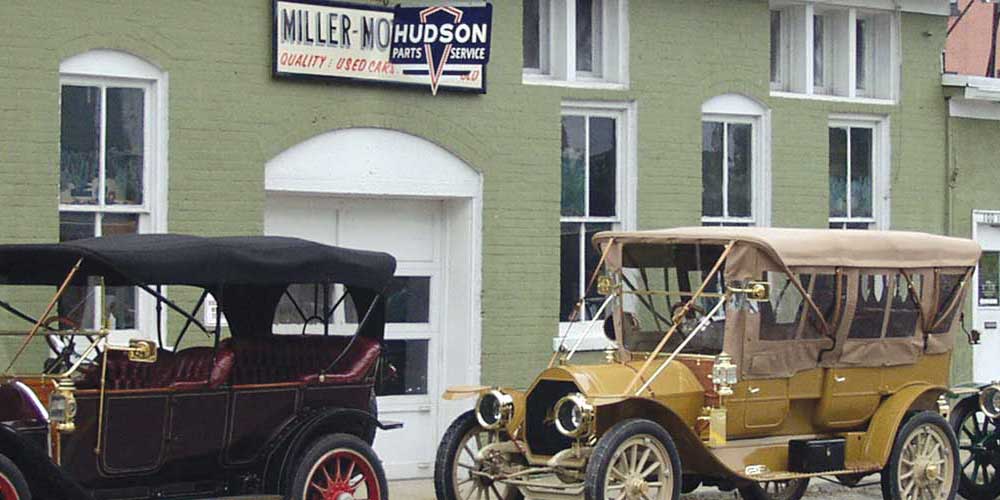By Robert Tate, Automotive Historian
Images courtesy of the National Automotive History Collection
Posted: 04.24.2017
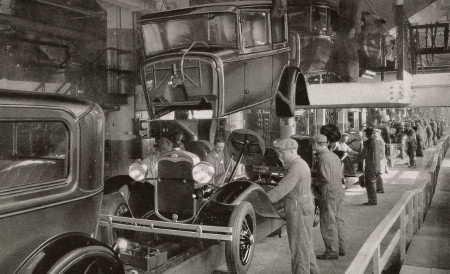 Ford assembly line at the Rouge Plant.From beginning to end of the manufacturing process, the 1930 Ford models were great looking vehicles.
Ford assembly line at the Rouge Plant.From beginning to end of the manufacturing process, the 1930 Ford models were great looking vehicles.
Some of the models were manufactured at the Rouge factory, which is still one of the largest industrial facilities in the world. When construction was completed in 1928, the Rouge Complex had an area of 1,096 acres, 92 miles of railroad track and one-third mile of docks where Great Lakes freighters would unload iron ore limestone and lumber.
This was the place where engine parts and engines were completely assembled. It was also the place where axle springs, radiators and other component parts of chassis were made along with body parts, hoods, fenders and body panels that were manufactured into the best-looking cars and trucks.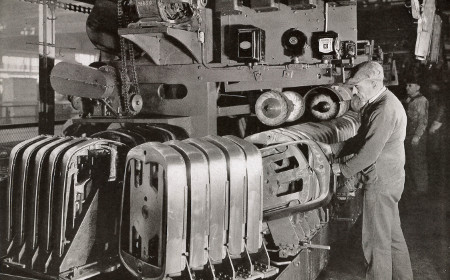 Ford worker polishing rust-less steel radiator shells on the assembly line.The 1930 Ford models offered the consumer more fender flare, deeper radiator shells and a great fuel economy for the consumer market. An unusual feature of the new Ford model for 1930 was the use of rust-less steel for the radiator shell headlamps, hubcaps, cowl finish strip and radiator caps. For many years, nickel plating was used for those parts by automobile manufacturers.
Ford worker polishing rust-less steel radiator shells on the assembly line.The 1930 Ford models offered the consumer more fender flare, deeper radiator shells and a great fuel economy for the consumer market. An unusual feature of the new Ford model for 1930 was the use of rust-less steel for the radiator shell headlamps, hubcaps, cowl finish strip and radiator caps. For many years, nickel plating was used for those parts by automobile manufacturers.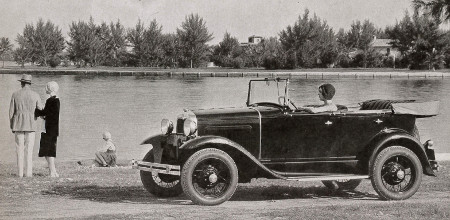 1930 Ford Phaeton by the lake.One of the popular models offered for 1930 was the De Luxe Phaeton models priced at $625. The 1930 Ford models offered the consumer smaller wheels and larger tires, a shatterproof glass windshield, new style fenders and many other features that many consumers thoroughly had enjoyed.
1930 Ford Phaeton by the lake.One of the popular models offered for 1930 was the De Luxe Phaeton models priced at $625. The 1930 Ford models offered the consumer smaller wheels and larger tires, a shatterproof glass windshield, new style fenders and many other features that many consumers thoroughly had enjoyed.
The Phaeton model was a great looking car that many customers really enjoyed. The windshield could fold flat when desired and the top could be raised or lowered quickly and easily. The door panels were attractively embossed and the model offered the driver outstanding performances when driving.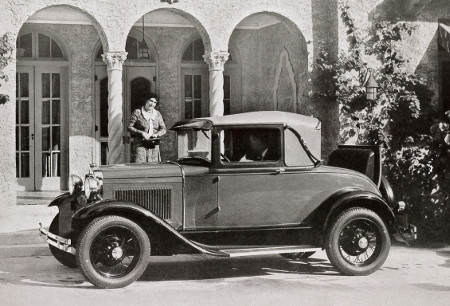 The 1930 Ford Sport Coupe.The 1930 Ford Sport Coupe model offered the consumer a great looking model that also sported a slick, new rumble seat for that special customer. The price tag for this model was $530.
The 1930 Ford Sport Coupe.The 1930 Ford Sport Coupe model offered the consumer a great looking model that also sported a slick, new rumble seat for that special customer. The price tag for this model was $530.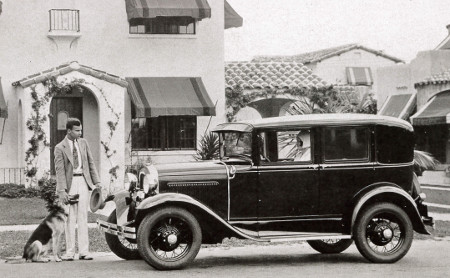 1930 Ford Deluxe SedanThe De Luxe sedan models offered the consumers very attractive lines, a dome light and a very stylish, innovative appearance for the customer.
1930 Ford Deluxe SedanThe De Luxe sedan models offered the consumers very attractive lines, a dome light and a very stylish, innovative appearance for the customer.
The new Ford Coupe model for 1930 offered the consumer a lower roofline and other unique features. It was a beautiful closed-body designed car that sold very well for the Ford Motor Company. The model even offered a parcel shelf behind the seat along with 14 cubic feet of luggage space in the rear deck, which made it a very nice looking business car.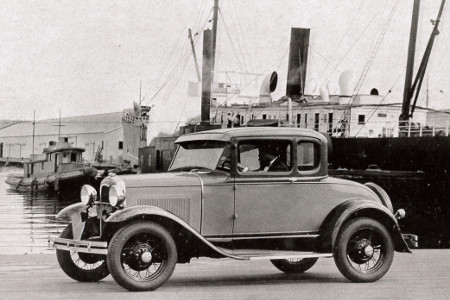 1930 Ford Coupe.The 1930 Ford models also offered the consumer highest quality with body panels and other parts being manufactured with the finest grades of steel. Many parts were electrically welded to give greater strength and rigidity. Panels and frame sections were welded or riveted together. In the large units, where bolts were necessary, strips of anti-squeak material were used between the sections. Before the interior was trimmed, workers installed sound–deadening material to suppress noise inside the cabin. Fuel economy for the 1930 Ford models was great for the consumer with the average driver getting between 20 and 30 miles per gallon.
1930 Ford Coupe.The 1930 Ford models also offered the consumer highest quality with body panels and other parts being manufactured with the finest grades of steel. Many parts were electrically welded to give greater strength and rigidity. Panels and frame sections were welded or riveted together. In the large units, where bolts were necessary, strips of anti-squeak material were used between the sections. Before the interior was trimmed, workers installed sound–deadening material to suppress noise inside the cabin. Fuel economy for the 1930 Ford models was great for the consumer with the average driver getting between 20 and 30 miles per gallon.
Other popular Ford models that were introduced in 1930 but not shown within this story were the Deluxe Roadster, which also featured a rumble seat; the standard Business Coupe that was a very popular model at just $500.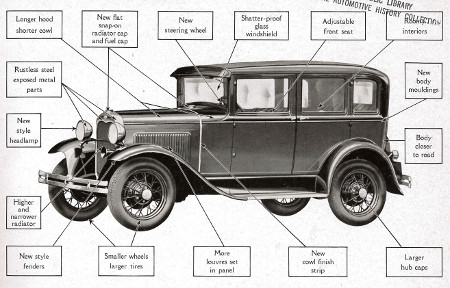 New features for the 1930 Ford models.In conclusion, on a historical note, Lorin Sorensen stated in the book “The American Ford,” “An estimated 400,000 people attended the first day's showing of the improved Model A. This had represented about one-fifth of the total number of passenger car owners in the country. Ford dealers have booked orders totaling $20 million already on the car.”
New features for the 1930 Ford models.In conclusion, on a historical note, Lorin Sorensen stated in the book “The American Ford,” “An estimated 400,000 people attended the first day's showing of the improved Model A. This had represented about one-fifth of the total number of passenger car owners in the country. Ford dealers have booked orders totaling $20 million already on the car.”
The Ford models for the model year 1930 will always be a special part of our automotive history and heritage.
For further information on photos please visit http://www.detroitpubliclibrary.org/ or email This email address is being protected from spambots. You need JavaScript enabled to view it.. Please do not republish the story and/or photographs without permission of MotorCities National Heritage Area. (Bibliography: Sorensen, Lorin. “The American Ford from the Fordiana series” Silverado Publishing Company1975; Dammann, H. George. “Illustrated History of Ford” Crestline publishing 1970; “The New Ford Advertising 1930,” The National Automotive History Collection.)
If you would like to contribute an article for the MotorCities newsletter, email This email address is being protected from spambots. You need JavaScript enabled to view it. or call 313-259-3425.


